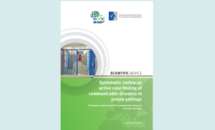Systematic review on active case finding of communicable diseases in prison settings
A higher prevalence of communicable diseases among people in prison compared with the general public is recognised as a public health issue as well as a major concern for the people affected, as the majority of incarcerated people return to their communities. Active case finding is a key prevention measure to promote early diagnosis, treatment and to prevent further disease transmission. The objective of this report is to systematically review the evidence on active case finding in prison settings, with a focus on the European Union (EU) and the European Economic Area (EEA) region. The communicable diseases targeted by this review were not selected a priori, but identified through the retrieved evidence.
Executive summary
ECDC and the European Monitoring Centre for Drugs and Drug Addiction (EMCDDA) have systematically retrieved and assessed evidence on active case findings for blood-borne viruses like HIV, hepatitis B and C, sexually transmitted infections as well as tuberculosis in prison settings in the EU/EEA.
Compared with the general public, people in prison have a higher prevalence of infection with HIV, hepatitis B, hepatitis C, syphilis, gonorrhoea, chlamydia and tuberculosis. Such increased prevalence of diseases among people in prisons is recognised as a major risk for the health of both people living and working in prison settings and for the general population, as the vast majority of people in prisons return to their communities after less than 24 months of incarceration. According to the principle of equivalence of care, people in prison should enjoy an equivalent standard of care as in the community. Yet, their health needs tend to be greater. Incarceration may thus represent a unique opportunity to make adequate healthcare services available to people and target groups that usually are hard to reach.
Active case finding to promote early diagnosis is a key measure to prevent onward transmission of communicable diseases and allow entry into care to individuals in need. As its broader implementation may be particularly relevant for prison settings, the available evidence was assessed in a systematic literature review, performed by ECDC and EMCDDA.
A need to strengthen case finding initiatives?
Despite some limitations, the findings provide a valid argument to strengthen case finding initiatives in prison settings. They also show that, in such settings, the way testing is organized and offered to people in detention, influences the uptake of tests for communicable diseases. For example, the available evidence suggests that the active offer of tests by health care provider yields a higher uptake compared with people in prison having to ask for test themselves. However, due to lack of research, current evidence does not provide a clear indication on the most effective timing and optimal testing modalities for these diseases in prison settings.
This systematic review highlights important knowledge gaps. More operational research is needed to assess the effectiveness of interventions to increase the offer and uptake of testing in prison settings.
The findings from this systematic review will serve as the evidence base for the development of ECDC and EMCDDA public health guidance on active case finding for communicable diseases in prison settings to be release in 2018. This guidance will be part of a broader set of guidance documents on prevention and control of communicable diseases in prison settings, which will encompass other specific interventions such as vaccination, and specific disease prevention and control methods.
In this context, ECDC and EMCDDA welcome the efforts of European HIV-Hepatitis Testing Week to increase positive dialogue among those who might benefit from being tested and those who offer tests across Europe.
Download

Publication data
Data
Appendices for Systematic review on active case finding of communicable diseases in prison settings
Appendix 1. Search and selection strategy for MA1, MA2 and MA3
Appendix 2. Quality appraisal checklists other than NICE
Appendix 3. Expert panel members and ECDC/EMCDDA staff
Appendix 4. Exclusion table peer-reviewed literature and corresponding reference list





